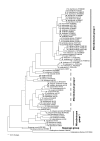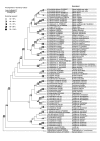Implications of molecular characters for the phylogeny of the Microbotryaceae (Basidiomycota: Urediniomycetes)
- PMID: 16638136
- PMCID: PMC1526759
- DOI: 10.1186/1471-2148-6-35
Implications of molecular characters for the phylogeny of the Microbotryaceae (Basidiomycota: Urediniomycetes)
Abstract
Background: Anther smuts of the basidiomycetous genus Microbotryum on Caryophyllaceae are important model organisms for many biological disciplines. Members of Microbotryum are most commonly found parasitizing the anthers of host plants in the family Caryophyllaceae, however they can also be found on the anthers of members of the Dipsacaceae, Lamiaceae, Lentibulariaceae, and Portulacaceae. Additionally, some members of Microbotryum can be found infecting other organs of mainly Polygonaceae hosts. Based on ITS nrDNA sequences of members of almost all genera in Microbotryaceae, this study aims to resolve the phylogeny of the anther smuts and their relationship to the other members of the family of plant parasites. A multiple analysis strategy was used to correct for the effects of different equally possible ITS sequence alignments on the phylogenetic outcome, which appears to have been neglected in previous studies.
Results: The genera of Microbotryaceae were not clearly resolved, but alignment-independent moderate bootstrap support was achieved for a clade containing the majority of the Microbotryum species. The anther parasites appeared in two different well-supported lineages whose interrelationship remained unresolved. Whereas bootstrap support values for some clades were highly vulnerable to alignment conditions, other clades were more robustly supported. The differences in support between the different alignments were much larger than between the phylogenetic optimality criteria applied (maximum parsimony and maximum likelihood).
Conclusion: The study confirmed, based on a larger dataset than previous work, that the anther smuts on Caryophyllaceae are monophyletic and that there exists a native North American group that diverged from the European clade before the radiation of the European species. Also a second group of anther smuts was revealed, containing parasites on Dipsacaceae, Lamiaceae, and Lentibulariaceae. At least the majority of the parasites of Asteraceae appeared as a monophylum, but delimitations of some species in this group should be reconsidered. Parasitism on Polygonaceae is likely to be the ancestral state for the Microbotryaceae on Eudicot hosts.
Figures



References
-
- Begerow D, Göker M, Lutz M, Stoll M. On the evolution of smut fungi and their hosts. In: Agerer R, Piepenbring M, Blanz P, editor. Frontiers in Basidiomycote Mycology. Eching: IHW Verlag; 2004. pp. 81–98.
-
- Thrall PH, Biere A, Antonovics J. Plant-life history and disease susceptibility – the occurrence of Ustilago violacea on different species within the Caryophyllaceae. J Ecol. 1993;81:489–498. doi: 10.2307/2261527. - DOI
Publication types
MeSH terms
Substances
LinkOut - more resources
Full Text Sources
Molecular Biology Databases

